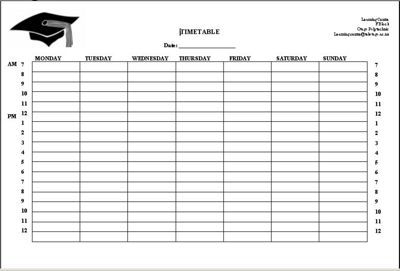Time Management/Activities/Weekly study schedule
From WikiEducator
Contents
Objectives
Demonstrate methods to facilitate efficient use of time in dealing with priorities
Create a timetable of your weekly schedule
- To create a Weekly Schedule, it is most important that you record all your obligations during a typical week. Do the following:
- Write down your class schedule, including labs, and your work hours if any.
- Every day of the week, show when you go to sleep and arise. Get the sleep you need.
- Allow an hour for lunch and two hours for dinner. These are times you can use to relax.
- List clubs, meetings, activities that you attend on a regular basis - including weekends.
- Plan to exercise three or four times a week. This is most important for good studies.
- Allow for free-time on Friday or Saturday nights. Show any TV time.
- Schedule time for naps if you tire readily. (Thomas Edison used naps most effectively.)
- The remaining time could be study time. Use a high lighter to mark blocks of time where you are willing to make a study commitment. Now, count your study hours. If they fit the 2:1 ratio, your Weekly Schedule is probably on track. If it's low, add more study time.
- Follow the schedule for a week, and revise it as needed. Make the schedule fit your needs.
Some Comments on Scheduling Study Hours
- The One Hour Block - The pervasive feeling is "What can I do in an hour?" The answer is quite a bit, but only if you plan it. It's a good time for low-level priority tasks, light review, floating tasks, short naps, quick trips, a snack; almost anything! Just plan it.
- The Eight or Ten-Hour Marathon - it looks good on the schedule, but in reality, long blocks of time are usually wasted. This happens because it's difficult to stay focused for long periods of time. Instead, break it up into two- and three-hour blocks with a break between.
- The Two or Three Hour Block - this is by far almost everyone's favorite.
Some Comments on Taking Study Breaks
- About every hour or two, get up and walk around for ten to twenty minutes. This is a short, active break. It gets the blood circulating again. It provides a transition from one study subject to another. It's not so long that it will get you out of study mode.
- At the end of the day, take a long two, three, or four hour break. Example: if you get out of class at 3 PM, go to the gym for a workout, go home to relax, eat, talk with friends, read the paper or watch some TV. Around 7 PM, hit the books again until midnight. After a four-hour break, you'll be really ready to jump into your studies
Support Materials
What is Procrastination?
Time Management Strategies
reference
Student Academic Services California Polytechnic State University Retrieved June 12, 2007, from [1]
